
Magento 2 Breadcrumbs Settings for SEO and Usability
Want to improve your Magento 2 store’s navigation? Magento 2 breadcrumbs settings play a key role in both user experience and SEO. You can optimize these settings for better SERP rankings.
In this article, we’ll explore how to handle SEO-specific breadcrumb setting issues. We’ll also guide you on managing breadcrumbs for CMS pages and multi-store setups.
Key Takeaways
-
Magento 2 breadcrumbs enhance SEO by improving site structure.
-
Proper breadcrumb setup boosts user experience and reduces bounce rates.
-
Multi-store setups allow for custom breadcrumb configurations.
-
SEO-specific issues like rich snippets and filtered navigation are easily resolved.
-
Removing breadcrumbs from specific CMS pages is straightforward with XML updates.
How Magento 2 Breadcrumbs Impact SEO?
Breadcrumbs are more than just navigation links on a webpage. They play a significant role in enhancing your Magento 2 SEO and improving user experience. Proper breadcrumbs can make your site easier for search engines to crawl and rank.
Key Benefits:
-
Improved Site Hierarchy: Breadcrumbs reflect the structure of your site. Such helps search engines index your pages correctly. It creates a better understanding of your website's content.
-
Rich Snippets: With proper breadcrumbs, Google can display rich snippets in search results. It improves visibility. Breadcrumbs often appear in search results. Such helps users directly navigate to the relevant section.
-
Enhanced User Experience: Breadcrumbs allow visitors to track their location within the site easily. It reduces bounce rates and encourages longer stays.
By configuring Magento 2 breadcrumbs settings, you can boost your site’s SEO. It creates a better user experience and helps your customers find products faster. It also allows search engines to understand your site's structure more clearly.
Post-Migration vs. Delta Migration: Breadcrumbs Settings Comparison
| Aspect | Post-Migration | Delta Migration |
|---|---|---|
| Configuration Transfer | Complete reset of breadcrumb settings. Manual reconfiguration is needed for all store views. | Preserves existing breadcrumb configurations. Only new changes require setup. |
| SEO Impact | Temporary drop in search rankings. Need to rebuild structured data markup. Takes 2-3 weeks for recovery | Minimal SEO disruption. Maintains existing rich snippets. Search rankings stay stable |
| Category Hierarchy | Full category tree rebuild required. All product-category associations need verification | Keeps existing category structures. Only new categories need configuration |
| Multi-Store Setup | Reset of store-specific breadcrumb settings. Language configurations need a manual update | Maintains store-view-specific settings. New stores inherit the default configuration |
| Cache Management | Full cache flush needed. All pages require cache rebuild. Performance impact for 24-48 hours | Selective cache updates. Only modified pages need cache refresh |
| URL Structure | Complete URL rewrite generation. All breadcrumb paths need validation. Higher server load | Preserves existing URL structure. Only new URLs need configuration |
Verdict: Post-migration requires extensive reconfiguration of breadcrumb settings. Plan for temporary SEO impact during setup. Schedule maintenance during low-traffic periods. Monitor search rankings closely after migration. Delta migration offers a smoother transition with minimal disruption. Regular backups prevent data loss during either process.
Handling SEO-Specific Magento 2 Breadcrumbs Settings Issues
| Issue | Solution | Example |
|---|---|---|
| Rich Snippet Implementation | Add structured data markup for breadcrumbs | json<script type="application/ld+json">{"@context": "https://schema.org","@type": "BreadcrumbList"} |
| Multi-Category Products | Set primary category in product settings | Product "Blue T-shirt" in both "Men's" and "Clothing" shows "Home > Men's > Blue T-shirt." |
| Language-Specific Paths | Configure store-view level breadcrumb text | English: "Home > Electronics", Spanish: "Inicio > Electrónicos" |
| Mobile Display Formatting | Adjust CSS for responsive design | Reduce font size and padding for small screens |
| URL Structure Conflicts | Update URL rewrites while maintaining breadcrumb logic | Custom URL: "/sale/shoes" maintains category path |
| Filtered Navigation | Add attribute parameters to the breadcrumb path | "Home > Shoes > Color: Blue > Size: 42" |
| Search Results Pages | Create dynamic breadcrumbs for search queries | "Home > Search Results > Query Term" |
| Category Priority | Set display order for multiple categories | Primary: "Electronics," Secondary: "Sale Items" |
| Custom Page Types | Implement breadcrumbs for non-standard pages | Blog posts: "Home > Blog > Post Title" |
| Pagination SEO | Add page numbers to the breadcrumb structure | "Category > Subcategory (Page 2 of 5)" |
6 Steps to Remove Breadcrumbs from a Specific CMS Page
By default, Magento 2 lacks individual CMS page breadcrumb controls. The Custom Layout Update Textarea option has been removed. This change occurred in Magento 2.3.4. The removal was implemented for security reasons. The option was previously available in the CMS page admin section.
To disable breadcrumbs on specific CMS pages, you must use XML configuration. The layout adjustments require manual XML updates.
Step 1: Go to your theme's layout folder:
Navigate to app/design/frontend/<VendorName>/<ThemeName>/Magento_Cms/layout/.
Step 2: Create a custom XML layout file:
-
Create a file named
cms_page_view_selectable_<PAGEIDENTIFIER>_<LayoutUpdateName>.xml. -
Replace
<PAGEIDENTIFIER>with the identifier of your CMS page (e.g.,about-us). Change<LayoutUpdateName>with any desired name (e.g.,AboutUs). Make sure you use a single word without spaces, dashes, or underscores.
Example: For an "About Us" page, the filename would be cms_page_view_selectable_about-us_AboutUs.xml.
Step 3: Add the XML code to remove breadcrumbs:
In the cms_page_view_selectable_<PAGEIDENTIFIER>_<LayoutUpdateName>.xml file, insert the following code:
<?xml version="1.0"?>
<page xmlns:xsi="http://www.w3.org/2001/XMLSchema-instance" xsi:noNamespaceSchemaLocation="urn:magento:framework:View/Layout/etc/page_configuration.xsd">
<body>
<referenceBlock name="breadcrumbs" remove="true"/>
</body>
</page>
Step 4: Flush the cache:
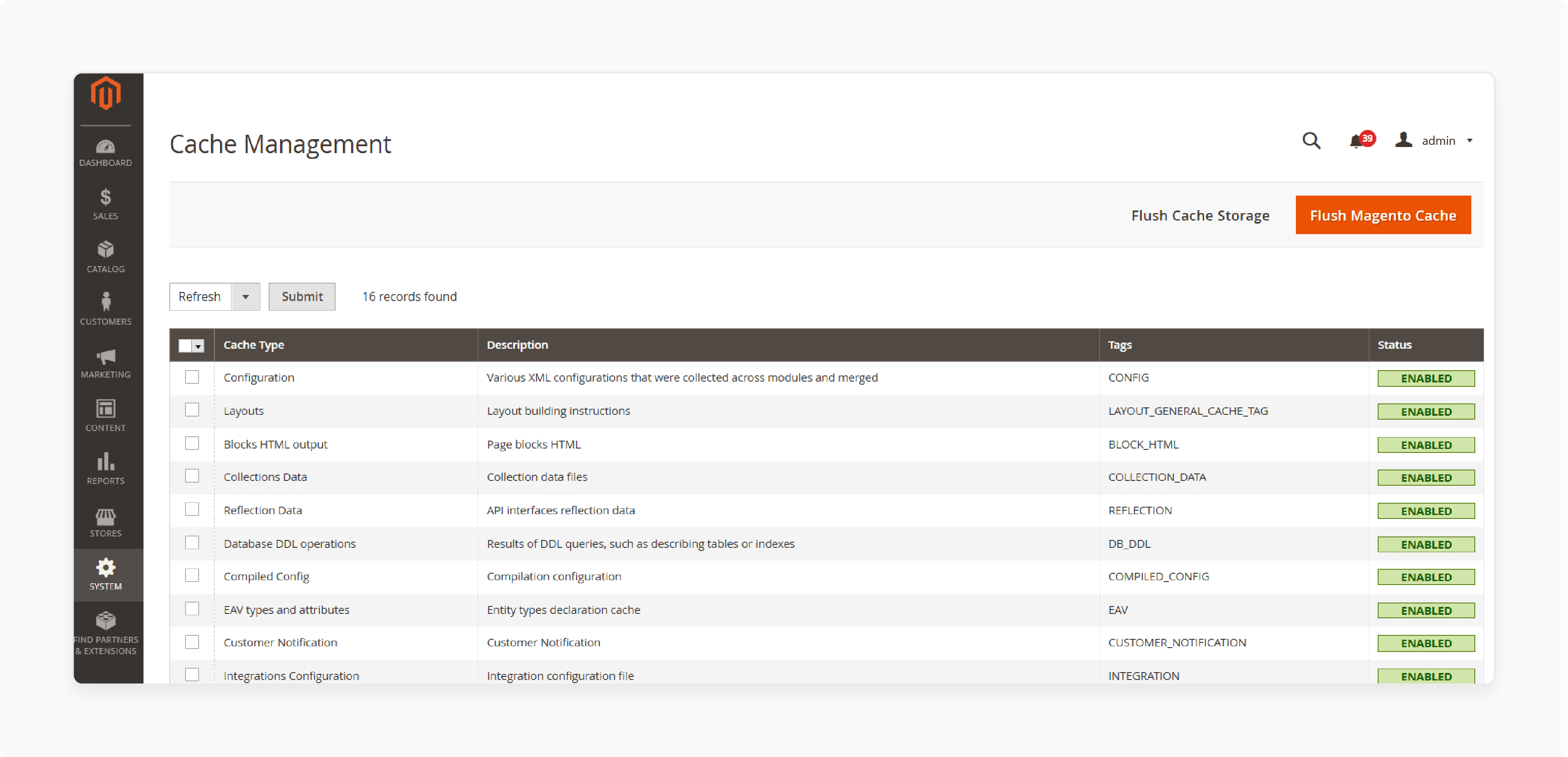
After saving the XML file, go to System > Cache Management and flush the cache.
Step 5: Set the custom layout in the backend:
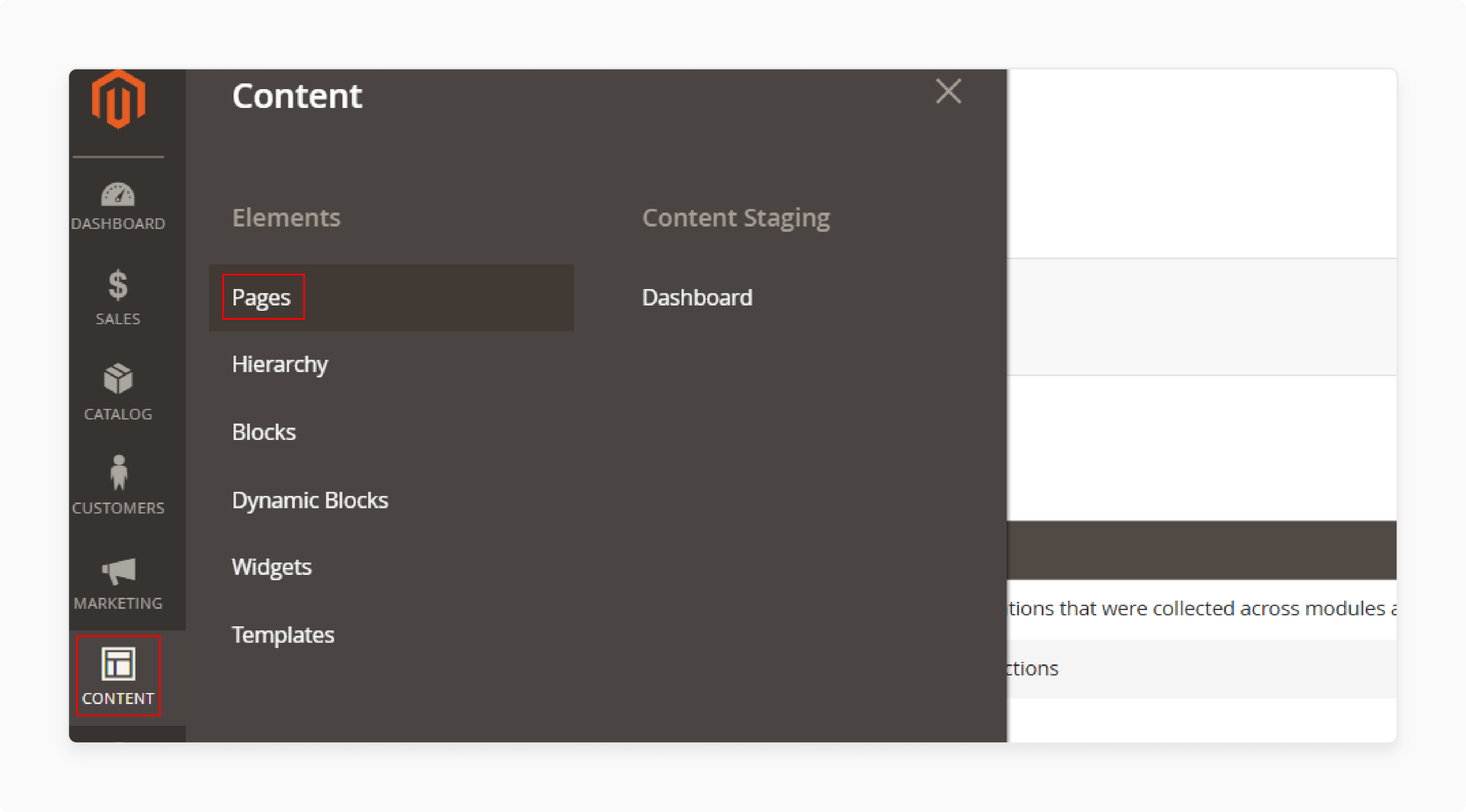
- Go to Content > Pages.
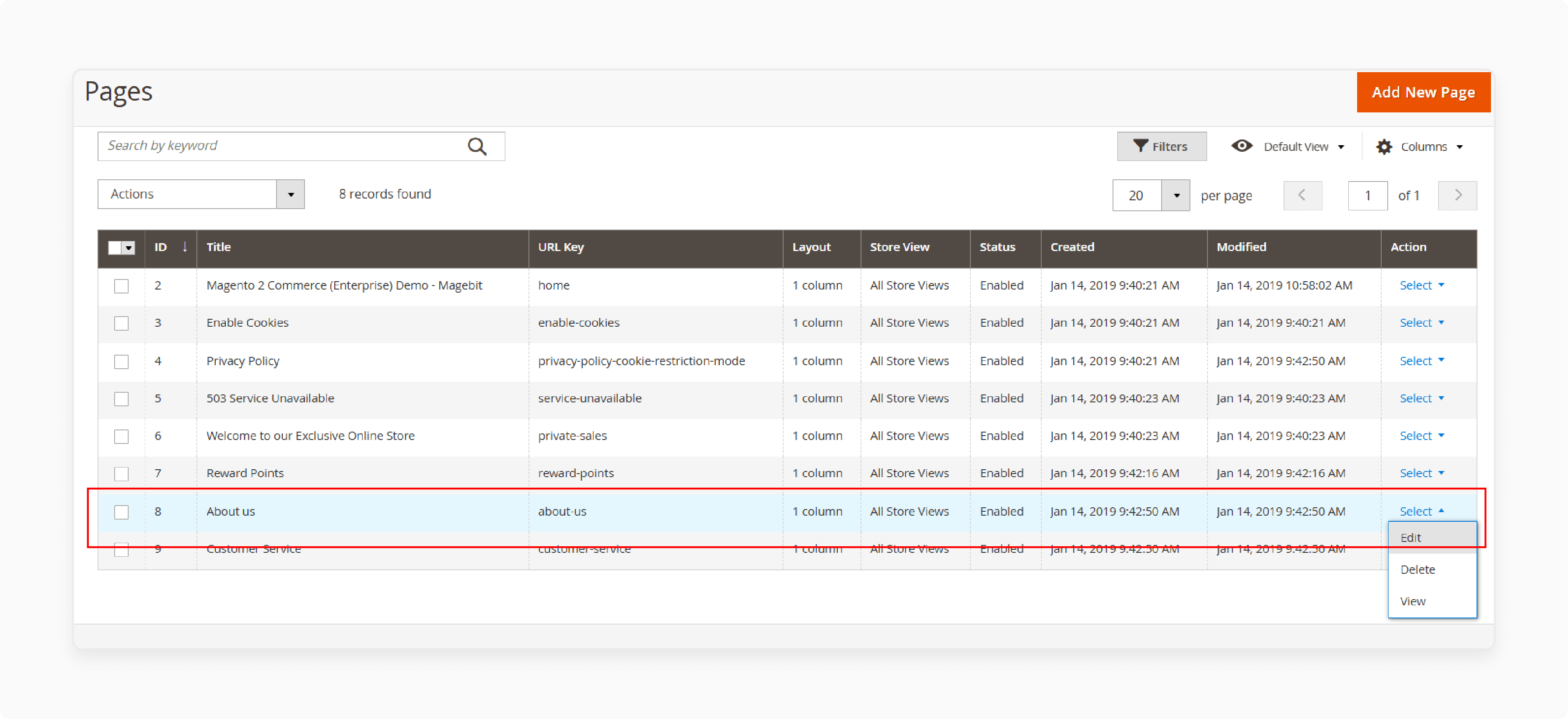
- Select the CMS page where you want to remove breadcrumbs.
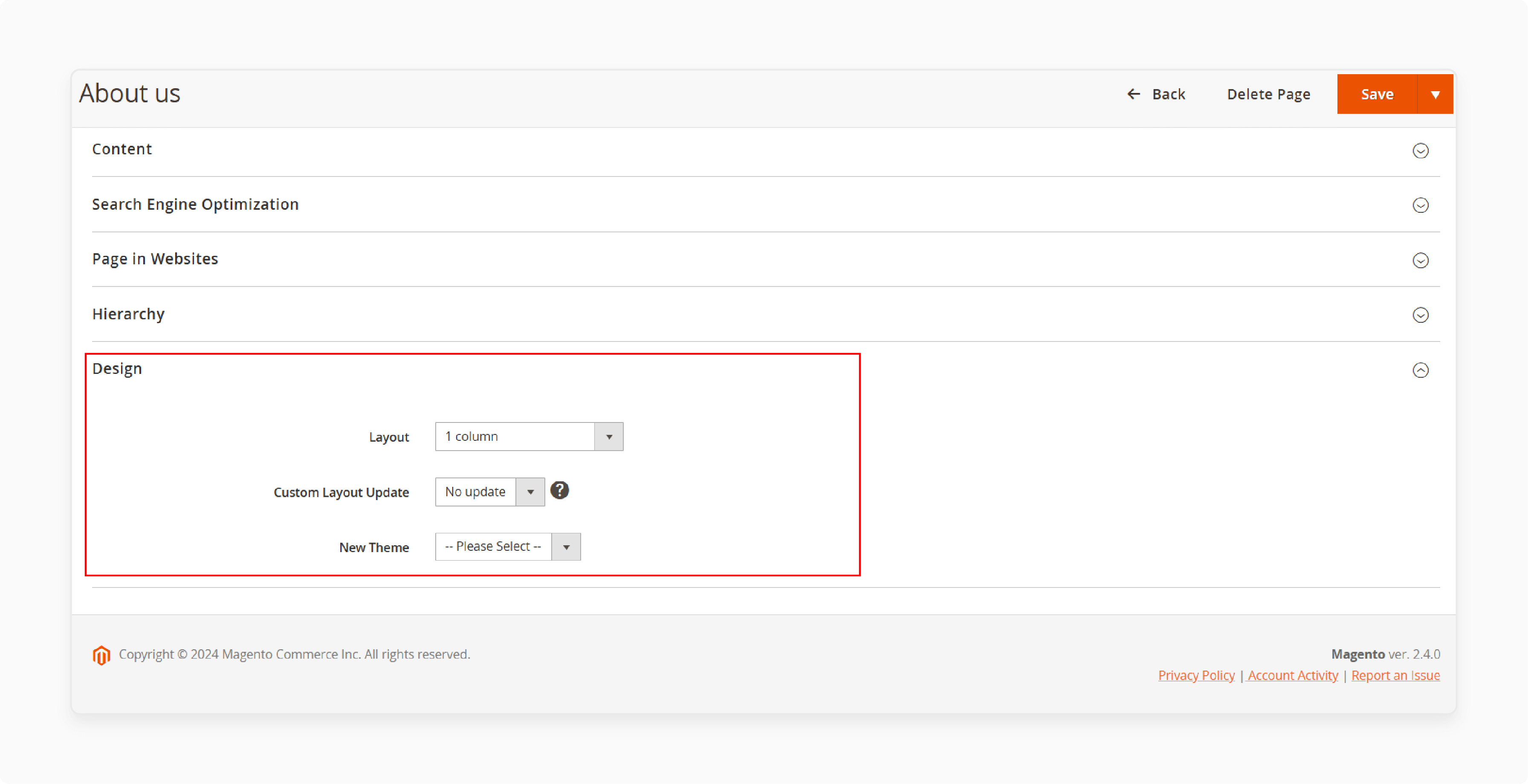
- Expand the Design section. Choose your custom layout update (e.g., AboutUs) in the Custom Layout Update field.
Step 6: Save and flush the cache:
After saving, clear the cache again to apply the changes.
Multi-Store Magento 2 Breadcrumbs Settings Tips
If you run a multi-store Magento 2 setup, managing breadcrumbs requires extra attention. Here are practical tips for configuring breadcrumbs in a multi-store environment:
1. Custom Breadcrumbs for Different Stores
-
Each Magento 2 store can have unique breadcrumbs tailored to its structure.
-
You can show different breadcrumbs for regional stores or category-specific pages.
Example: A US store can show breadcrumbs for US-based categories. UK stores can display breadcrumbs relevant to the UK market.
2. Use Attribute-Based Breadcrumbs
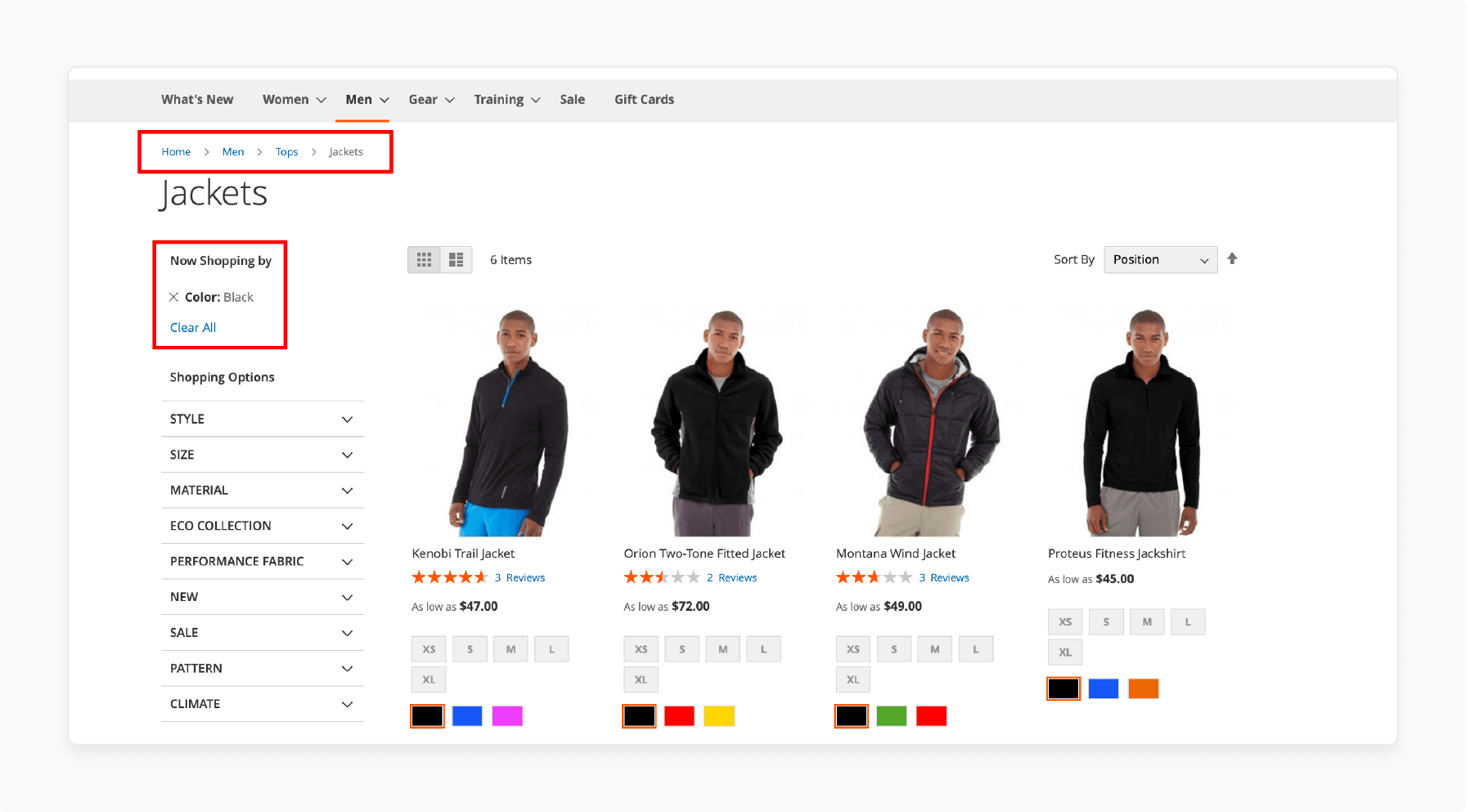
-
For products, use attribute-based breadcrumbs like brand or color.
-
This customization enhances the user experience by providing more relevant breadcrumb paths.
Example: A customer viewing a red shirt sees relevant breadcrumbs. These breadcrumbs reflect the red product category.
3. Dynamic Breadcrumbs Based on User Data
-
Adjust breadcrumbs based on customer data.
-
Show breadcrumbs reflecting the product filters or the customer's location.
4. Create Hierarchical Breadcrumbs

-
Use hierarchical breadcrumbs to reflect the site’s category structure.
-
A simple hierarchy improves clarity.
5. Disable or Customize Breadcrumbs for Specific Stores
-
If certain stores don’t need breadcrumbs, you can disable or adjust them.
-
Do it as per the store in the Magento admin panel.
FAQs
1. What are the common types of breadcrumbs in magento 2?
Three main breadcrumb types exist in Magento 2. Hierarchy-based breadcrumbs display website structure and navigation paths. History-based breadcrumbs show previously visited pages like a back button. Attribute-based breadcrumbs present product filters and category selections. Each type serves specific navigation purposes in magento store layouts.
2. How do breadcrumbs help with search engine optimization?
Breadcrumbs make website structure clear to search engines. Search engines understand page relationships through breadcrumb navigation. Rich snippets from breadcrumbs appear in search results. Keyword-rich breadcrumbs improve ranking signals. Pages with breadcrumbs often receive better SERP positions.
3. Where are breadcrumbs located on the product page in magento?
Breadcrumbs appear below the header section on product pages. The position remains consistent across category and product pages. Default magento 2 displays breadcrumbs above the main content area. Navigation paths clearly show the current page location.
4. Can I customize breadcrumbs for cms pages in magento 2?
Yes, cms page breadcrumbs offer multiple customization options. Navigate to Stores > Configuration > Web > Default Pages. Set the "Show Breadcrumbs for CMS Pages" option. Add custom templates through XML layout updates. Configure display settings per store view.
5. What is the shortest breadcrumb path for product pages?
The shortest path follows the Store – Category – Product format. Magento 2 advanced breadcrumbs extension enables path customization. Users can select between the shortest and longest paths. Category priority settings determine the final breadcrumb display.
6. How do history-based breadcrumbs work in a magento store?
History-based breadcrumbs track user navigation patterns. Users can return to previous pages instantly. Selected filters remain active during backward navigation. The system maintains shopping session continuity through breadcrumbs.
7. What are the seo benefits of using breadcrumbs?
Breadcrumbs reduce bounce rates through improved navigation. Search engines better understand website hierarchy through breadcrumbs. Rich snippets enhance SERP visibility and click-through rates. Structured data from breadcrumbs improves overall SEO performance.
Summary
Proper Magento 2 breadcrumb settings validation prevents navigation issues. Monitor breadcrumb paths for accuracy and consistency. Below mentioned are the key highlights from the article:
-
Cache management affects breadcrumb performance. Clear relevant caches after configuration changes.
-
Category hierarchy determines breadcrumb structure. Maintain organized category relationships for clear paths.
-
Rich snippets enhance search visibility. Implement structured data for improved SERP display.
-
Mobile optimization requires specific attention. Test breadcrumb display across different devices.
-
Multi-store configurations need separate management. Configure each store view's breadcrumb settings independently.
Managed Magento hosting aids with professional breadcrumb restructuring support.




